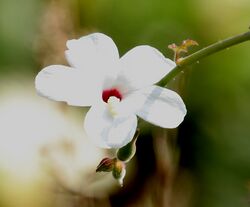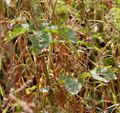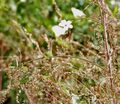Biology:Abelmoschus ficulneus
| Abelmoschus ficulneus | |
|---|---|

| |
| Scientific classification | |
| Kingdom: | Plantae |
| Clade: | Tracheophytes |
| Clade: | Angiosperms |
| Clade: | Eudicots |
| Clade: | Rosids |
| Order: | Malvales |
| Family: | Malvaceae |
| Genus: | Abelmoschus |
| Species: | A. ficulneus
|
| Binomial name | |
| Abelmoschus ficulneus | |
| Synonyms | |
| |
Abelmoschus ficulneus is a species of flowering plant in the genus Abelmoschus, family Malvaceae. Commonly known as white wild musk mallow or native rosella, it is fibrous perennial with a woody stem. Its flowers are about an inch in diameter, either pink or white, with a rose center;[2] its leaves are palmate.[3]
The species grows as a small erect shrub, 2 to 5 ft (1 to 2 m) tall and 2 to 6 ft (1 to 2 m) across. Leaves are 5 to 8 cm (2 to 3 in) long and 4 to 7 cm (2 to 3 in) wide, with a circular shape (heart-shaped near base). Leaves are rough on both sides, toothed, and have 3 to 5 lobes. Flower stock are covered in velvety hair, and the flowers themselves are 5 to 7 cm (2 to 3 in) across. The stocks are short and colored white to pink with a dark purple center. Flowers last a few days. The plant has small hairs which may cause irritation.[3] The plant's seed heads are hairy and sticky, ovalar in shape and 2.5–4 cm (1–2 in) long and 1.3–2 cm (1–1 in) wide, with five ribs and a short beak. Seeds that are still in their growth period are medium to dark green, and when they are mature they turn dark brown, and split into five parts to release 10 to 20 brown to black spherical seeds, covered in tiny hairs.[4]
Abelmoschus ficulneus germinates in the spring and summer months, after the effects of rainfall and irrigation have set in. The plant grows rapidly over spring and summer several months after emergence, through autumn. Mature seeds are produced within a month of flowering in the late summer and autumn seasons.[4]
The species is native to north and east Africa, Madagascar, Indomalaya and Northern Australia, where it has become a common crop weed, particularly in cotton.[2][3][4]
Gallery
References
- ↑ Allen, R.; Plummer, J. (2019). "Abelmoschus ficulneus". IUCN Red List of Threatened Species 2019: e.T123707362A123802086. https://www.iucnredlist.org/species/123707362/123802086. Retrieved 25 June 2022.
- ↑ 2.0 2.1 2.2 {{citation | mode = cs1 | title = Abelmoschus ficulneus | work = Germplasm Resources Information Network (GRIN) | url = | publisher = [[Organization:Agricultural Research ServAgricultural Research Service (ARS), United States Department of Agriculture (USDA) | access-date = 29 July 2010 }}
- ↑ 3.0 3.1 3.2 3.3 "White Wild Musk Mallow". Flowers of India. http://www.flowersofindia.net/catalog/slides/White%20Wild%20Musk%20Mallow.html. Retrieved 29 July 2010.
- ↑ 4.0 4.1 4.2 "Native rosella". Cotton Catchment Communities. http://www.cottoncrc.org.au/content/Industry/Publications/Weeds/WeedIdentificationTools/Weedsbycommonnames/Nativerosella.aspx. Retrieved 29 July 2010.
Wikidata ☰ Q4666724 entry
 |





